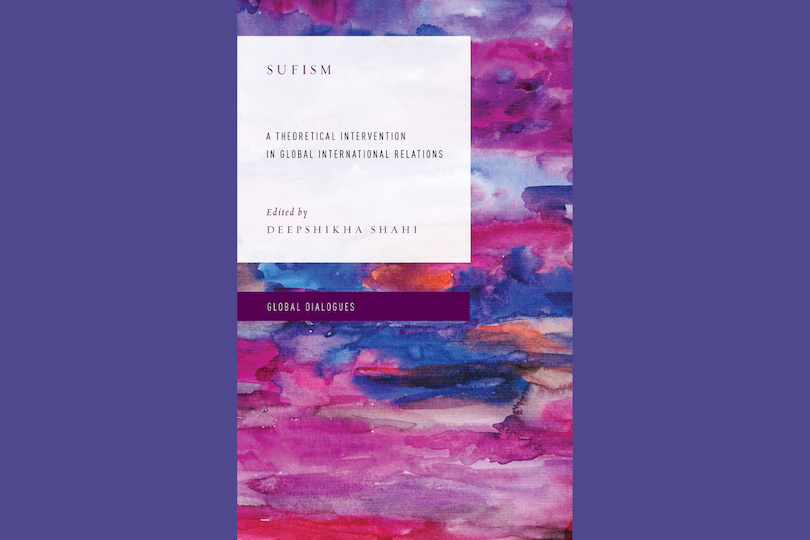Sufism: A Theoretical Intervention in Global International Relations
Edited by Deepshikha Shahi
Rowman & Littlefield, 2020
A captivating guide which broadly succeeds at bringing collectively an eclectic group of subjects in a single quantity, which covers lofty theoretical grounds corresponding to a brand new ontological, epistemological and methodological method for IR, in addition to extra empirically grounded research of Sufism in follow in Syria, Turkey, the USA, and extra. The melding of those two poles is testomony to the robust path by editor Deepshikha Shahi, in back and front ending the guide with clear focus and sense of function.
Broadly talking the guide teases on the promise of ‘Sufi IR’, which is a body of theorising which avoids the pitfalls of some submit/decolonial principle. Most fun is the best way through which, it’s argued, Sufi IR doesn’t unwittingly restate Eurocentric classes, corresponding to a specific principle for a specific folks (versus a common Eurocentric principle for all peoples), or a by-product of pre-established common (Eurocentric) thought solely linguistically differentiated as belonging to this or that tradition. Shahi tries to maneuver the dialog away from such binaries, stating: “[it] doesn’t should be at all times about ‘common vs. provincial’ (or Western versus non-Western); it is also about ‘common together with provincial’ (or Western together with non-Western)” (p.6). The excellence between common and specific is sort of central to the theme of the guide, making an attempt to hyperlink the ‘many worlds’ of humanity’s lived experiences to ‘one world’, which unites us as a species (p.210). As such, the guide speaks to the issue, if perceived as such, whereby a lot postcolonial principle can readily critique IR’s Eurocentric universalism, however solely sheepishly, if in any respect, forwards a distinct or corrected ontological and epistemological place. Sufi IR does simply that, utilizing the idea of “oneness of actuality/wahdat al-wujud” (p.47) to border an epistemological monism – a complete and its elements defined in reference to 1 actuality. Monism is contrasted to epistemological dualism which is indicative of the self-discipline of IR (and the broader social sciences) at massive, separating ideas into binaries to be contested over: historical past or philosophy; chronology or covariance; language or idea; tradition or economic system; single or plural (p.202). The bridge between plurality and oneness, because it seems, is the guts. Shahi explains that “the rational school of thoughts is expert in discerning the plurality of human experiences, the emotional school of coronary heart is expert in recognizing singularity throughout the plurality of human experiences” (p.14). The argument is definitely contentious, but in addition completely fascinating.
Theoretical contributions
The guide is break up into 4 elements; Half 1 is deeply theoretical, Components 2 and three are extra empirically knowledgeable, and Half 4 features because the guide’s conclusion. In Half 1, we begin with Ali Balci’s chapter on a Sufi re-reading of the knowledge-power nexus. The chapter exhibits how al-Ghazali and Ibn al-Arabi relate to the development of energy/data within the Foucauldian sense. This isn’t an unproblematic comparability to modern poststructuralist thought, nevertheless, and care is taken to point out that whereas there may be similarity, there are necessary variations (p.35). The latter sections relate on to the undertaking of International IR and appear the richest with chance. The chapter is provocative and exhibits convincingly that that is fertile floor for additional research. Ending Half 1 is Shahi’s chapter on Rumi and International Worldwide Relations. It’s daring in its claims, arguing {that a} Sufi method, as learn via Rumi on this occasion, makes ontology inconsequential, methodology eclectic, and epistemology monistic (collapsing distinctions like positivist/post-positivist and so on) (p.51). Nevertheless, the chapter is complicated and extremely abstracted when in comparison with most of the different contributions, making it a troublesome, if rewarding learn.
Non-Western Sufism in follow
Half 2 brings empirical insights from non-Western worlds (Syria, Turkey, Sudan and Arab historical past), whereas Half 3 does the identical from Western worlds (Europe and the USA). I’ll sort out these sections collectively. Fait Muedini’s chapter on the idea of ‘Oneness of Actuality’ pertains to the flexibility for social science to amalgamate the numerous differentiated experiences of humanity right into a ‘oneness’, or singular manner of figuring out the world (p.69). The chapter gives an fascinating description of how such an idea might be present in a large number of non secular traditions internationally, however its relation to IR, International or in any other case, is speculative at finest. Such hypothesis, 4 chapters into the guide, appears misplaced. One other traditionally knowledgeable chapter is Giuseppe Cecere’s contribution on the bounds of the idea of ‘Oneness of Actuality’. This chapter is a welcome contextualisation of Sufi masters of their historic intervals, compared to textual evaluation of their work which may obfuscate the primacy of divine revelation within the understanding of monism. Reasonably, for Cecere, Sufism creates a distinct type of dualism, “between subjective-human-inspiration and objective-divine-revelation” (p.118). It’s definitely a compelling chapter, however is extra a research of Sufi follow and principle, and fewer an try to relate this to IR. As such, regardless of potential, the chapter requires some work from an IR readership to bridge the hole. Then once more, such bridging could properly must be a methodological dedication of International IR, and we have to develop an understanding of the mental histories of various cultures, the identical manner we count on totally different cultures to have an understanding of European mental historical past.
Transferring onto the country-specific chapters, Omar Imady’s chapter on Sufism in Syria gives a superb grounding of what have been, till now, fairly summary concepts. Imady relates Sufi concepts to Islamist uprisings in Syria within the 80s and 90s, transferring from the micro of Syria to the macro of International IR. It’s much less a dialog about IR as a self-discipline, and extra an exploration of the intersection (and limits) of thought and follow. Within the Syrian case, the chapter argues that Sufism’s means to breakdown “identitarian gaps” (p.95) via the idea of oneness, had been a contributing issue to Grand Mufti Kaftaru’s battle decision efforts within the time interval studied. Way more vital of Sufi praxis is Ayşe Çavdar’s chapter on Sufi orders in Turkey, which warns in opposition to universalising or abstracting Sufi philosophy from follow, fairly in opposition to the overall thrust of the quantity to this point. The follow of Sufi orders in Turkey highlights the exclusionary mechanisms which might be concerned, calling into query the inclusiveness of Sufism as an abstraction; “Sufi tariqas [orders]… don’t chorus from settling contained in the communitarian borders and acquiring energy from them” [sic] (p.135). As data types that stem from the European Enlightenment (liberalism) are additionally being re-evaluated by putting them of their historic context (slavery), it’s admirable that such work can also be current right here, stopping the embrace of utopian goals within the object of Sufi IR.
This brings me to the ultimate chapter on non-Western Sufi experiences, but in addition probably the most problematic chapter of the quantity. Specializing in the lifetime of the Sudanese author and politician Mahmud Muhammad Taha, the creator Meir Hatina gives an introduction to the life and work of this compelling Sufi mental, however the utility to a) the Arab-Israeli battle and b) IR usually is missing. Initially is the best way through which Taha’s troubling assumptions about ‘the Arabs’ versus a benign Israel usually are not critically engaged with. When the chapter claims that “[i]n reality, [for Taha] Israel functioned as a mirror for the Arabs, highlighting their faults, and subsequently it was mandatory to succeed in out for a peace with it” (p.154), it appears to me to be reinforcing an Orientalist dualism between inherently ‘backwards/intolerant’ Arabs and ‘civilised/liberal’ Israel. Addressing this side of Taha’s writing might properly be illuminating, a lot because the chapter on Turkey was. Most unusual, nevertheless, is the tangential manner through which Sufism is mobilised. Taha appears, on this studying, extra an analogue for liberalism reasonably than Sufism, and if there’s a dialogue available concerning the relationship between liberalism and Sufism, it’s not discovered right here.
Western Sufism in follow
Starting the part on Sufism within the West, Elena Furlanetto and Shahi’s chapter on the US discourse on Sufism can also be a considerably disappointing chapter. Filled with suppositions and assumed linkages between Sufism and US civic faith or the heritage of that civil faith, the chapter doesn’t, to my thoughts, learn as notably convincing. The chapter depends on perceived similarities in verse reasonably than extra concrete examples of journey writing or translations, that are talked about, however not explored in the identical manner as verse is. Furthermore, the US Enlightenment runs alongside the extermination and expropriation of native peoples, however this colonialism shouldn’t be historicised, however reasonably the ‘(neo)colonialism’ is when Sufism is appropriated, indifferent from its Islamic roots. Heavy with speak of ‘compatibility’ and ‘multifaith/multiculturalism’ (p.173), the chapter doesn’t interact with the notion of US multiculturalism as itself a racist assemble linked to structural inequality (for a extra polemical introduction to this concept see: Philips, 2004; for a tutorial introduction see: Cornell & Murphy, 2002). The ultimate chapter on this part on the European discourse on Sufism, sees R. James Ferguson present a improbable appraisal of Sufism in Europe, its heritage, modern place and future prospects. The chapter attracts properly on Sufi rules to narrate them to modern political processes, notably European integration. Furthermore, Sufism’s function in interfaith dialogue and wishes by European governments to ‘use’ it to enhance societal cohesion is brilliantly problematised; in a single case, British Sufism is sponsored by the state solely to see authorities distance itself from the factor it has created, “to keep away from divisive responses from Muslim communities” (p.186). In one other case, Russian appropriation of a Chechen Sufi order “had little to do with the inclusive, tolerant, and mystical Sufi attributes”, however reasonably “remained chained to the Russian authorities’s pursuits” (p.187). The examples present properly the issue with state appropriation of ‘Western pleasant’ or ‘apolitical’ Islam.
Tying all of it collectively
Lastly, Shahi takes us again to the summary questions of heart-mind distinctions, trying to sq. the circle between data of the thoughts, which identifies distinction, and data of the guts, which recognises similarities. The chapter takes a shocking psychological flip, trying to point out how hierarchy in worldwide relations, and the resultant ache and struggling that the robust can inflict on the weak, and vice versa, results in “repetitive backlashes of the identical pain-experience” (p.222). It’s once more contentious, however participating. What confuses issues is that this argument was not alluded to in earlier chapters and so serves as an ‘add on’, after the chapter makes an attempt to conclude with abstract and synthesis of the previous contributions. It’s not an unwelcome learn, however extra maybe might have been completed to ‘conclude’ extra forcefully and produce collectively the disparate threads totally different chapters have woven – considering particularly concerning the theory-praxis distinction that most of the chapters make. As it’s, such issues are talked about briefly, which leaves one with the distinct (and questionable) impression that Sufi IR actually is a utopian concept which could resolve any variety of crises.
Total, the guide has some compelling chapters, a few of which will definitely be of curiosity to IR students grappling with the self-discipline’s Eurocentric heritage. As Shahi relates of the Helveti-Jerrahi Sufi order within the USA, “[a]nyone that walks within the door is welcome” (p.172), however be sure you convey your spirituality to have interaction with the provocations inside this quantity – not one thing I imagined ever saying about an IR textual content!








